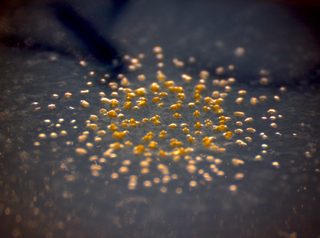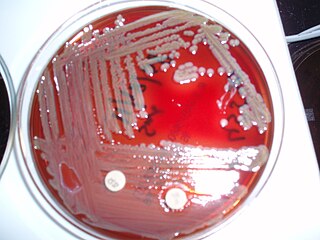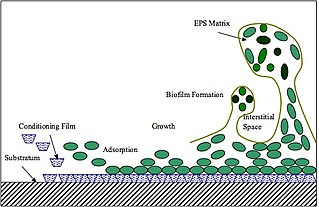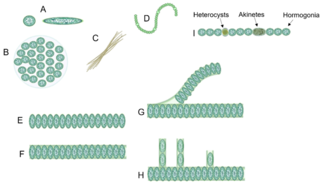Related Research Articles

A microorganism, or microbe, is an organism of microscopic size, which may exist in its single-celled form or as a colony of cells.

A biofilm comprises any syntrophic consortium of microorganisms in which cells stick to each other and often also to a surface. These adherent cells become embedded within a slimy extracellular matrix that is composed of extracellular polymeric substances (EPSs). The cells within the biofilm produce the EPS components, which are typically a polymeric conglomeration of extracellular polysaccharides, proteins, lipids and DNA. Because they have three-dimensional structure and represent a community lifestyle for microorganisms, they have been metaphorically described as "cities for microbes".
In biology, quorum sensing or quorum signaling (QS) is the ability to detect and respond to cell population density by gene regulation. Quorum sensing is a type of cellular signaling, and more specifically can be considered a type of paracrine signaling. However, it also contains traits of both autocrine signaling: a cell produces both the autoinducer molecule and the receptor for the autoinducer. As one example, QS enables bacteria to restrict the expression of specific genes to the high cell densities at which the resulting phenotypes will be most beneficial, especially for phenotypes that would be ineffective at low cell densities and therefore too energetically costly to express. Many species of bacteria use quorum sensing to coordinate gene expression according to the density of their local population. In a similar fashion, some social insects use quorum sensing to determine where to nest. Quorum sensing in pathogenic bacteria activates host immune signaling and prolongs host survival, by limiting the bacterial intake of nutrients, such as tryptophan, which further is converted to serotonin. As such, quorum sensing allows a commensal interaction between host and pathogenic bacteria. Quorum sensing may also be useful for cancer cell communications.

The myxobacteria are a group of bacteria that predominantly live in the soil and feed on insoluble organic substances. The myxobacteria have very large genomes relative to other bacteria, e.g. 9–10 million nucleotides except for Anaeromyxobacter and Vulgatibacter. One species of myxobacteria, Minicystis rosea, has the largest known bacterial genome with over 16 million nucleotides. The second largest is another myxobacteria Sorangium cellulosum.
A slime layer in bacteria is an easily removable, unorganized layer of extracellular material that surrounds bacteria cells. Specifically, this consists mostly of exopolysaccharides, glycoproteins, and glycolipids. Therefore, the slime layer is considered as a subset of glycocalyx.

Paenibacillus is a genus of facultative anaerobic, endospore-forming bacteria, originally included within the genus Bacillus and then reclassified as a separate genus in 1993. Bacteria belonging to this genus have been detected in a variety of environments, such as: soil, water, rhizosphere, vegetable matter, forage and insect larvae, as well as clinical samples. The name reflects: Latin paene means almost, so the paenibacilli are literally "almost bacilli". The genus includes P. larvae, which causes American foulbrood in honeybees, P. polymyxa, which is capable of fixing nitrogen, so is used in agriculture and horticulture, the Paenibacillus sp. JDR-2 which is a rich source of chemical agents for biotechnology applications, and pattern-forming strains such as P. vortex and P. dendritiformis discovered in the early 90s, which develop complex colonies with intricate architectures as shown in the pictures:

Myxococcus xanthus is a gram-negative, bacillus species of myxobacteria that exhibits various forms of self-organizing behavior in response to environmental cues. Under normal conditions with abundant food, it exists as a predatory, saprophytic single-species biofilm called a swarm. Under starvation conditions, it undergoes a multicellular development cycle.

Bacteria are ubiquitous, mostly free-living organisms often consisting of one biological cell. They constitute a large domain of prokaryotic microorganisms. Typically a few micrometres in length, bacteria were among the first life forms to appear on Earth, and are present in most of its habitats. Bacteria inhabit soil, water, acidic hot springs, radioactive waste, and the deep biosphere of Earth's crust. Bacteria play a vital role in many stages of the nutrient cycle by recycling nutrients and the fixation of nitrogen from the atmosphere. The nutrient cycle includes the decomposition of dead bodies; bacteria are responsible for the putrefaction stage in this process. In the biological communities surrounding hydrothermal vents and cold seeps, extremophile bacteria provide the nutrients needed to sustain life by converting dissolved compounds, such as hydrogen sulphide and methane, to energy. Bacteria also live in symbiotic and parasitic relationships with plants and animals. Most bacteria have not been characterised and there are many species that cannot be grown in the laboratory. The study of bacteria is known as bacteriology, a branch of microbiology.

The class Flavobacteriia is composed of a single class of environmental bacteria. It contains the family Flavobacteriaceae, which is the largest family in the phylum Bacteroidota. This class is widely distributed in soil, fresh, and seawater habitats. The name is often spelt Flavobacteria, but was officially named Flavobacteriia in 2012.

Extracellular polymeric substances (EPSs) are natural polymers of high molecular weight secreted by microorganisms into their environment. EPSs establish the functional and structural integrity of biofilms, and are considered the fundamental component that determines the physicochemical properties of a biofilm. EPS in the matrix of biofilms provides compositional support and protection of microbial communities from the harsh environments. Components of EPS can be of different classes of polysaccharides, lipids, nucleic acids, proteins, lipopolysaccharides, and minerals.

Bacterial motility is the ability of bacteria to move independently using metabolic energy. Most motility mechanisms that evolved among bacteria also evolved in parallel among the archaea. Most rod-shaped bacteria can move using their own power, which allows colonization of new environments and discovery of new resources for survival. Bacterial movement depends not only on the characteristics of the medium, but also on the use of different appendages to propel. Swarming and swimming movements are both powered by rotating flagella. Whereas swarming is a multicellular 2D movement over a surface and requires the presence of surfactants, swimming is movement of individual cells in liquid environments.

A prokaryote is a single-cell organism whose cell lacks a nucleus and other membrane-bound organelles. The word prokaryote comes from the Ancient Greek πρό 'before' and κάρυον 'nut, kernel'. In the two-empire system arising from the work of Édouard Chatton, prokaryotes were classified within the empire Prokaryota. But in the three-domain system, based upon molecular analysis, prokaryotes are divided into two domains: Bacteria and Archaea. Organisms with nuclei are placed in a third domain, Eukaryota.

Gliding motility is a type of translocation used by microorganisms that is independent of propulsive structures such as flagella, pili, and fimbriae. Gliding allows microorganisms to travel along the surface of low aqueous films. The mechanisms of this motility are only partially known.
Roberto Kolter is Professor of Microbiology, Emeritus at Harvard Medical School, an author, and past president of the American Society for Microbiology. Kolter has been a professor at Harvard Medical School since 1983 and was Co-director of Harvard's Microbial Sciences Initiative from 2003-2018. During the 35-year term of the Kolter laboratory from 1983 to 2018, more than 130 graduate student and postdoctoral trainees explored an eclectic mix of topics gravitating around the study of microbes. Kolter is a fellow of the American Association for the Advancement of Science and of the American Academy of Microbiology.

Paenibacillus vortex is a species of pattern-forming bacteria, first discovered in the early 1990s by Eshel Ben-Jacob's group at Tel Aviv University. It is a social microorganism that forms colonies with complex and dynamic architectures. P. vortex is mainly found in heterogeneous and complex environments, such as the rhizosphere, the soil region directly influenced by plant roots.
Microorganisms engage in a wide variety of social interactions, including cooperation. A cooperative behavior is one that benefits an individual other than the one performing the behavior. This article outlines the various forms of cooperative interactions seen in microbial systems, as well as the benefits that might have driven the evolution of these complex behaviors.
Stigmatella aurantiaca is a member of myxobacteria, a group of gram-negative bacteria with a complex developmental life cycle.

Myxococcus is a genus of bacteria in the family Myxococcaceae. Myxococci are Gram-negative, spore-forming, chemoorganotrophic, obligate aerobes. They are elongated rods with rounded or tapered ends, and they are nonflagellated. The cells move by gliding and can predate other bacteria. The genus has been isolated from soil.

Social motility describes the motile movement of groups of cells that communicate with each other to coordinate movement based on external stimuli. There are multiple varieties of each kingdom that express social motility that provides a unique evolutionary advantages that other species do not possess. This has made them lethal killers such as African trypanosomiasis, or Myxobacteria. These evolutionary advantages have proven to increase survival rate among socially motile bacteria whether it be the ability to evade predators or communication within a swarm to form spores for long term hibernation in times of low nutrients or toxic environments.

Cyanobacterial morphology refers to the form or shape of cyanobacteria. Cyanobacteria are a large and diverse phylum of bacteria defined by their unique combination of pigments and their ability to perform oxygenic photosynthesis.
References
- 1 2 3 Rennie J (13 November 2017). "The Beautiful Intelligence of Bacteria and Other Microbes". Quanta Magazine.
- ↑ Ford, Brian J. (2004). "Are Cells Ingenious?" (PDF). Microscope. 52 (3/4): 135–144.
- 1 2 3 4 5 Chimileski S, Kolter R (2017). Life at the Edge of Sight: A Photographic Exploration of the Microbial World. Cambridge, Massachusetts: Harvard University Press. ISBN 9780674975910.
- ↑ Cohen, Inon, et al. (1999). "Continuous and discrete models of cooperation in complex bacterial colonies" (PDF). Fractals. 7.03 (1999) (3): 235–247. arXiv: cond-mat/9807121 . doi:10.1142/S0218348X99000244. S2CID 15489293. Archived from the original (PDF) on 2014-08-08. Retrieved 2014-12-25.
- ↑ Beagle SD, Lockless SW (November 2015). "Microbiology: Electrical signalling goes bacterial". Nature. 527 (7576): 44–5. Bibcode:2015Natur.527...44B. doi: 10.1038/nature15641 . PMID 26503058.
- ↑ Muñoz-Dorado J, Marcos-Torres FJ, García-Bravo E, Moraleda-Muñoz A, Pérez J (2016-05-26). "Myxobacteria: Moving, Killing, Feeding, and Surviving Together". Frontiers in Microbiology. 7: 781. doi: 10.3389/fmicb.2016.00781 . PMC 4880591 . PMID 27303375.
- ↑ Kaiser D (2013-11-12). "Are Myxobacteria intelligent?". Frontiers in Microbiology. 4: 335. doi: 10.3389/fmicb.2013.00335 . PMC 3824092 . PMID 24273536.
- ↑ Islam ST, Vergara Alvarez I, Saïdi F, Guiseppi A, Vinogradov E, Sharma G, et al. (June 2020). "Modulation of bacterial multicellularity via spatio-specific polysaccharide secretion". PLOS Biology. 18 (6): e3000728. doi: 10.1371/journal.pbio.3000728 . PMC 7310880 . PMID 32516311.
- ↑ Escalante A. "Scientists Just Brought Us One Step Closer To A Living Computer". Forbes. Retrieved 18 May 2020.
- ↑ "They remember: Communities of microbes found to have working memory". phys.org. Retrieved 18 May 2020.
- ↑ Yang CY, Bialecka-Fornal M, Weatherwax C, Larkin JW, Prindle A, Liu J, et al. (May 2020). "Encoding Membrane-Potential-Based Memory within a Microbial Community". Cell Systems. 10 (5): 417–423.e3. doi:10.1016/j.cels.2020.04.002. PMC 7286314 . PMID 32343961.
- ↑ "The 'sultan of slime': Biologist continues to be fascinated by organisms after nearly 70 years of study". Princeton University. Retrieved 2019-12-06.
- ↑ "Can a single-celled organism 'change its mind'? New study says yes". phys.org. Retrieved 2019-12-06.
- ↑ Tang SKY; Marshall, W. F. (22 October 2018). "Cell learning". Current Biology. 28 (20): R1180–R1184. doi: 10.1016/j.cub.2018.09.015 . PMC 9673188 . PMID 30352182. S2CID 53031600.
- ↑ Alipour A, Dorvash M, Yeganeh Y, Hatam G (2017-11-29). "Paramecium Learning: New Insights and Modifications". bioRxiv: 225250. doi: 10.1101/225250 .
- ↑ Kunita I, Yamaguchi T, Tero A, Akiyama M, Kuroda S, Nakagaki T (May 2016). "A ciliate memorizes the geometry of a swimming arena". Journal of the Royal Society, Interface. 13 (118): 20160155. doi:10.1098/rsif.2016.0155. PMC 4892268 . PMID 27226383.
- ↑ "Computing with slime: Logical circuits built using living slime molds". ScienceDaily. Retrieved 2019-12-06.
- ↑ Adamatzky A, Akl S, Alonso-Sanz R, Van Dessel W, Ibrahim Z, Ilachinski A, et al. (2013-06-01). "Are motorways rational from slime mould's point of view?". International Journal of Parallel, Emergent and Distributed Systems. 28 (3): 230–248. arXiv: 1203.2851 . doi:10.1080/17445760.2012.685884. ISSN 1744-5760. S2CID 15534238.
- ↑ "Slime Mold Can Solve Exponentially Complicated Problems in Linear Time | Biology, Computer Science | Sci-News.com". Breaking Science News | Sci-News.com. Retrieved 2019-12-06.
- 1 2 Agarwal L, Qureshi A, Kalia VC, Kapley A, Purohit HJ, Singh RN (2014-05-25). "Arid ecosystem: Future option for carbon sinks using microbial community intelligence". Current Science. 106 (10): 1357–1363. JSTOR 24102481.
- ↑ Ferreira C, Kalantari Z, Salvati L, Canfora L, Zambon I, Walsh R (2019-01-01). "Chapter 6: Urban Areas". Soil Degradation, Restoration and Management in a Global Change Context. Advances in Chemical Pollution Environmental Management and Protection. Vol. 4. p. 232. ISBN 978-0-12-816415-0 . Retrieved 2020-01-05.
- ↑ Zhang L, Lueders T (September 2017). "Micropredator niche differentiation between bulk soil and rhizosphere of an agricultural soil depends on bacterial prey". FEMS Microbiology Ecology. 93 (9). doi: 10.1093/femsec/fix103 . PMID 28922803.
